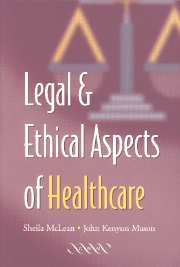Book contents
- Frontmatter
- Contents
- Acknowledgements
- Dedication
- Preface
- A Note on Abbreviations
- 1 About Medicine and the Law
- 2 Resources – Who Decides?
- 3 The Confidential Relationship
- 4 The Therapeutic Partnership
- 5 Refusal of Consent
- 6 Medical Negligence
- 7 Using People for Research
- 8 Assisted Reproduction
- 9 Genetics and Pregnancy
- 10 Termination of Pregnancy
- 11 Genetics, Insurance and Employment
- 12 Is Life Worth Living?
- 13 Disposal of the Body and Body Parts
- 14 Sex, Gender and the Law
- 15 Mental Health and Mental Capacity
- 16 The Law and the Elderly
- Index
10 - Termination of Pregnancy
Published online by Cambridge University Press: 24 August 2009
- Frontmatter
- Contents
- Acknowledgements
- Dedication
- Preface
- A Note on Abbreviations
- 1 About Medicine and the Law
- 2 Resources – Who Decides?
- 3 The Confidential Relationship
- 4 The Therapeutic Partnership
- 5 Refusal of Consent
- 6 Medical Negligence
- 7 Using People for Research
- 8 Assisted Reproduction
- 9 Genetics and Pregnancy
- 10 Termination of Pregnancy
- 11 Genetics, Insurance and Employment
- 12 Is Life Worth Living?
- 13 Disposal of the Body and Body Parts
- 14 Sex, Gender and the Law
- 15 Mental Health and Mental Capacity
- 16 The Law and the Elderly
- Index
Summary
We use the words ‘termination of pregnancy’ rather than ‘abortion’ for three main reasons. First, abortion can be confused with miscarriage or the unexpected and unintended loss of the foetus due to natural processes; what we are discussing here is the intended ending of a pregnancy which would otherwise be expected to progress normally. Secondly, abortion is identified in the minds of many people as criminal abortion – that is, abortion performed or attempted outside the medical arena. And, finally, and on much the same grounds, we believe that the word ‘abortion’ is highly emotive. Its use is probably responsible for the sometimes passionate approach that is adopted to legal termination of pregnancy – and it is the legal termination of pregnancy that is our main focus of attention.
On the other side of the coin, it might be questioned why we devote a whole chapter to the subject. ‘Surely,’ it will be said, ‘we have had an Abortion Act for over 30 years. Its working well, there is no problem’ – and this is true, but only up to a point. We have been spared the violence associated with abortion that we have seen developing in the United States only because the British have, fortunately, been able to look at the problems in a reasoned way, recognising that, within a diverse public, we must find a middle way between extreme positions.
- Type
- Chapter
- Information
- Legal and Ethical Aspects of Healthcare , pp. 131 - 146Publisher: Cambridge University PressPrint publication year: 2003



